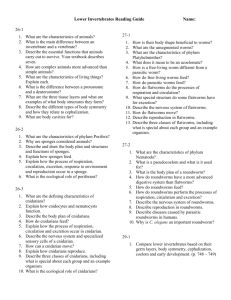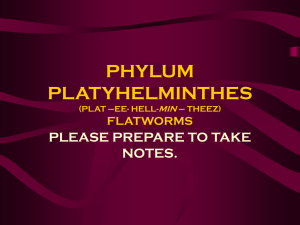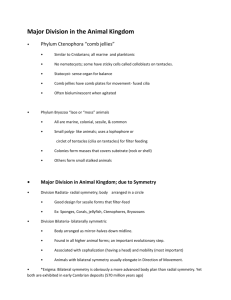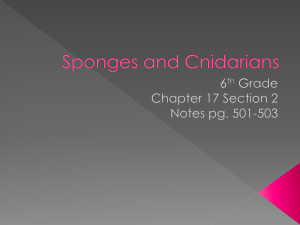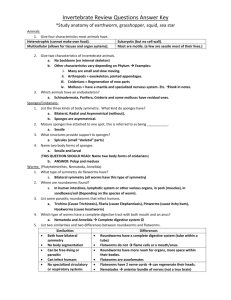CHAPTER OUTLINE
advertisement
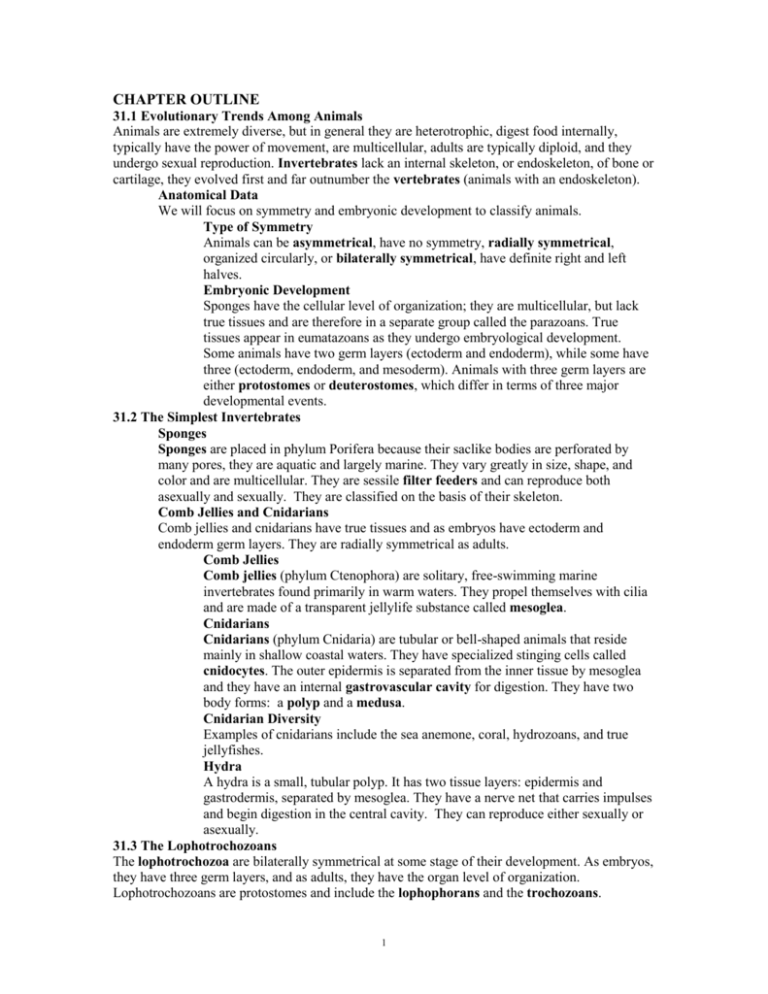
CHAPTER OUTLINE 31.1 Evolutionary Trends Among Animals Animals are extremely diverse, but in general they are heterotrophic, digest food internally, typically have the power of movement, are multicellular, adults are typically diploid, and they undergo sexual reproduction. Invertebrates lack an internal skeleton, or endoskeleton, of bone or cartilage, they evolved first and far outnumber the vertebrates (animals with an endoskeleton). Anatomical Data We will focus on symmetry and embryonic development to classify animals. Type of Symmetry Animals can be asymmetrical, have no symmetry, radially symmetrical, organized circularly, or bilaterally symmetrical, have definite right and left halves. Embryonic Development Sponges have the cellular level of organization; they are multicellular, but lack true tissues and are therefore in a separate group called the parazoans. True tissues appear in eumatazoans as they undergo embryological development. Some animals have two germ layers (ectoderm and endoderm), while some have three (ectoderm, endoderm, and mesoderm). Animals with three germ layers are either protostomes or deuterostomes, which differ in terms of three major developmental events. 31.2 The Simplest Invertebrates Sponges Sponges are placed in phylum Porifera because their saclike bodies are perforated by many pores, they are aquatic and largely marine. They vary greatly in size, shape, and color and are multicellular. They are sessile filter feeders and can reproduce both asexually and sexually. They are classified on the basis of their skeleton. Comb Jellies and Cnidarians Comb jellies and cnidarians have true tissues and as embryos have ectoderm and endoderm germ layers. They are radially symmetrical as adults. Comb Jellies Comb jellies (phylum Ctenophora) are solitary, free-swimming marine invertebrates found primarily in warm waters. They propel themselves with cilia and are made of a transparent jellylife substance called mesoglea. Cnidarians Cnidarians (phylum Cnidaria) are tubular or bell-shaped animals that reside mainly in shallow coastal waters. They have specialized stinging cells called cnidocytes. The outer epidermis is separated from the inner tissue by mesoglea and they have an internal gastrovascular cavity for digestion. They have two body forms: a polyp and a medusa. Cnidarian Diversity Examples of cnidarians include the sea anemone, coral, hydrozoans, and true jellyfishes. Hydra A hydra is a small, tubular polyp. It has two tissue layers: epidermis and gastrodermis, separated by mesoglea. They have a nerve net that carries impulses and begin digestion in the central cavity. They can reproduce either sexually or asexually. 31.3 The Lophotrochozoans The lophotrochozoa are bilaterally symmetrical at some stage of their development. As embryos, they have three germ layers, and as adults, they have the organ level of organization. Lophotrochozoans are protostomes and include the lophophorans and the trochozoans. 1 Lophophorans are aquatic and have a feeding apparatus called the lophophore. The trochophores either have a trochophore larva today, or an ancestor had one in the past. Flatworms Flatworms have an extremely flat body, an incomplete digestive tract, and no body cavity. Some are free-living and others are parasitic, they lack respiratory and circulatory systems. Free-Living Flatworms Planarians have an excretory and a nervous system. They capture food and digest it in the gastrovascular cavity. They can reproduce both sexually and asexually. Planarians typically cross-fertilize, even though they are hermaphrodites. Parasitic Flatworms The parasitic flatworms include the tapeworms and the flukes. Tapeworms Tapeworms are endoparasites of various vertebrates, including humans. They attach to the intestinal wall of the host and feed. Flukes Flukes are endoparasites of various vertebrates. They are usually named for the type of vertebrate organ they inhabit. Rotifers Rotifers are trochozoans related to the flatworms. Rotifers have a crown of cilia, known as the corona, on their heads. Most live in freshwater, but some are marine and terrestrial. Molluscs The mollusks are the second most numerous group of animals and inhabit a variety of environments. They have a true coelom, bilateral symmetry, three germ layers, the organ level of organization, and a complete digestive tract. The Unique Characteristics of Molluscs All molluscs have a body composed of at least three parts: the visceral mass, the foot, and the mantle. They also often have a radula, a tonguelike organ that is used to obtain food. Gastropods Gastropods include nudibranchs, conchs, and snails. The foot is ventrally flattened and the animal moves by muscle contractions that pass along it. Cephalopods Cephalopods include octopuses, squid, and nautiluses. The foot has evolved into a funnel or siphon about the head. They move by jet propulsion of water. Bivalves Bivalves include clams, mussels, oysters, and scallops. Their shells have two parts. The Visceral Mass The clam has an open circulatory system and a heart. It also has a nervous system and a digestive system. Annelids Annelids are segmented, have a hydrostatic skeleton, and specialization of the digestive tract. They have an extensive closed circulatory system. Polychaetes Marine annelids are the Polychaeta, which refers to the presence of many setae. Setae are bristles that anchor the worm or help it move. Oligochaetes The oligochaetes, which include earthworms, have few setae per segment. Segmentation 2 Segmentation is evidenced by body rings, coelom divided by septa, setae on most segments, ganglia and lateral nerves in each segment, nephridia in most segments, and branch blood vessels in each segment. Reproduction Earthworms are hermaphroditic. When mating, two worms lie parallel to each other facing in opposite directions. Comparison with Clam Worm The comparison of the marine clam worm with the terrestrial earthworm highlights the manner in which earthworms are adapted to life on land. Leeches Leeches have no setae and each body ring has several transverse grooves. Among their modifications are two suckers that attach themselves to open wounds if they are fluid feeders. 31.4 The Ecdysozoa The ecdysozoans and trochozoa are protostomes. The term ecdysis means molting, and both roundworms and arthropods periodically shed their outer covering. Roundworms Roundworms are nonsegmented worms that are prevalent in almost any environment. They possess a pseudocoelom, a body cavity incompletely lined by mesoderm Ascaris Ascaris are most commonly parasites of humans and pigs and females are very reproductively prolific. Other Roundworms Trichinosis is a fairly serious infection caused by eating pork that is not fully cooked that contains encysted larvae of the round worm Trichinella spiralis. Elephantiasis is caused by a roundworm called the filarial worm, causing the limbs of an infected human to swell to an enormous size due to the impediment of fluid return. Pinworm and hookworm infections are more common in the United States. Arthropods Arthropods are extremely diverse. They have jointed appendages and an exoskeleton made of chitin. Their success is dependent on: a rigid, but jointed exoskeleton, segmentation, a well-developed nervous system, a variety of respiratory organs and reduced competition through metamorphosis. Crustaceans Crustaceans are a group of largely marine arthropods that include barnacles, shrimps, lobsters, and crabs. They are named for their hard shells. Internal Organs The digestive system includes a stomach. The coelom is reduced to a space around the reproductive system. They have an open circulatory system. In crayfish, the nervous system is very similar to that of an earthworm. Insects Insects are very numerous and diverse. Insects have a body that is divided into a head, a thorax, and an abdomen. The head bears sensory antennae, a pair of compound eyes, and several simple eyes. The mouthparts are adapted to the way of life. Wings may be present. Internal Organs The digestive system of a grasshopper is suitable for an herbivorous diet; there is an excretory system, a respiratory system, and a circulatory system. 3 Reproduction and Development Grasshopper reproduction is adapted to life on land. Metamorphosis is a change in form and physiology that occurs as an immature stage, called a larva, becomes an adult. Comparison with Crayfish The grasshopper and crayfish share a common ancestor, but they have diverged in their morphology to adapt to aquatic versus terrestrial environments. Arachnids The arachnids include scorpions, spiders, ticks, and mites. They have six pairs of appendages. 31.5 Invertebrate Deuterostomes Chordates are most closely related to the echinoderms as witnessed by their similar embryological development. Characteristics of Echinoderms Echinoderms are a diverse group of marine animals. They have an endoskeleton and are often radially symmetrical. Echinoderm Diversity Echinoderms are quite diverse and include sea lilies, motile feather stars, brittle stars, and sea cucumbers. Sea Stars Sea stars have a five-rayed body with an oral and an aboral side. Locomotion depends on their water vascular system. They do not have a respiratory, excretory, or circulatory system. Sea stars reproduce both asexually and sexually. 4
